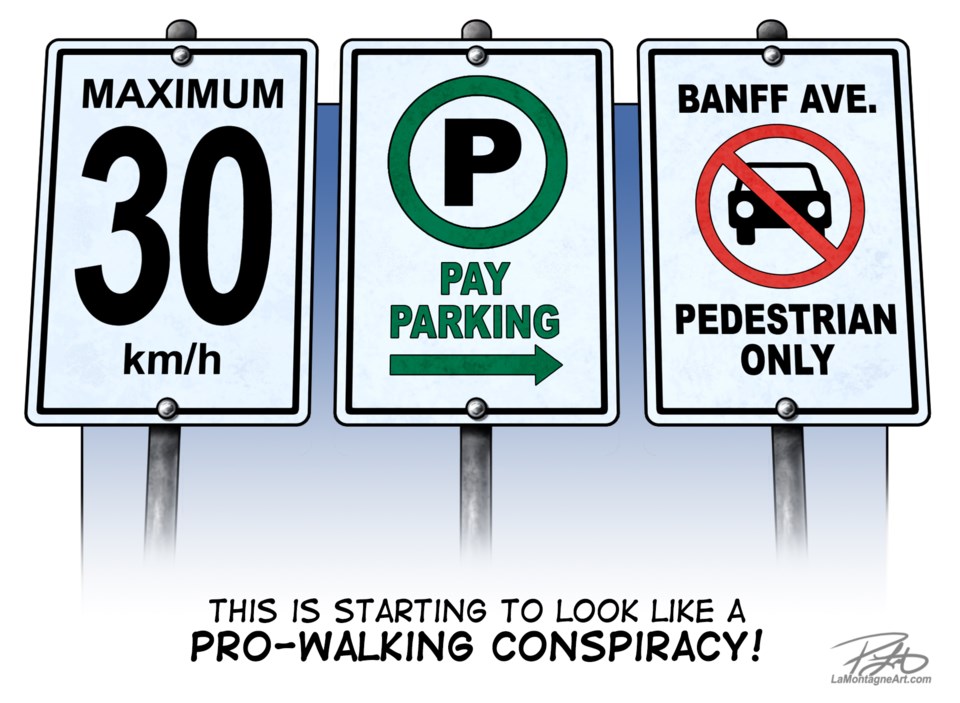There are few topics that can result in as much anger as paid parking.
You drive around with one eye on the road and the other scanning for an available spot. After several frustrating minutes that seem like hours, you finally find one only to realize you have to pay.
And while local paid parking programs give residents an opportunity to get passes or a certain amount of free hours to avoid dipping into their wallets, the frustration is real.
But with a system in place in Banff and one likely expanding to downtown Canmore this year, the reality is it’s here to stay and will likely only grow.
The concept was intended – and still remains – to ease the levels of growing congestion placed on the community's infrastructure that has skyrocketed due to growth, but primarily tourism. The offshoot, however, is the added revenue brought in by the paid parking that can be used elsewhere for community needs.
For the municipal leadership in Banff and Canmore, there is little option in raising revenue for tourism with the province of Alberta continuing to be resistant to granting resort municipality status to the two tourist-based communities.
While the status has become common in areas of British Columbia, successive provincial governments in Alberta have been largely muted on granting the status.
Though visitors bring in money for local businesses, they also bring in increased infrastructure needs from basic necessities such as road repairs, increased water and wastewater capacity and policing and fire services.
While the Bow Valley may only have about 30,000 permanent residents, the reality is the millions of visitors each year balloon the overall population and stress existing services.
Without the resort municipality status, the burden of paying for those services largely falls on residents.
Banff launched its visitor paid parking system this past year, with the cost to park at $3 per hour from May 1 to Oct. 31 and $2 the remainder of the year.
The gross revenue for the system last year was $1.3 million, but only $162,000 was net revenue due to high start-up costs. However, with the initial capital costs out of the way, it’s anticipated the profit in 2022 will be $1.58 million, $1.75 million in 2023 and $1.82 million in 2024.
Banff council has asked for a comprehensive report from Town staff on the program that could lead to possibly expanding the visitor paid parking and residential parking permit system into other areas of the community.
The report will likely return by the end of March or in April and have options for rate changes.
Of course, in Banff, there’s also the added advantage of the train station's free nine-hour parking lot if people choose to avoid paid parking.
Canmore saw early success with its paid parking program for Quarry Lake.
Originally projected to bring in about $80,000 in net revenue for Town coffers, the real figure was closer to $220,000 as visitors still flocked to the popular lake and were more than willing to pay.
Of that, $138,000 will go to increase local Roam transit to 35-minute runs and an extra $50,000 from the paid parking will go into increasing the Sunday bus service.
Though visitors aren’t directly paying for it, the paid parking has helped Canmore increase its public transit options for locals and visitors.
Downtown parking in Canmore was delayed in 2020 and 2021 because of the COVID-19 pandemic, but the success of the Quarry Lake program will likely see it move forward at some point this year.
Parks Canada has also jumped on board with a two-year pilot project for paid parking at Lake Louise from mid-May to mid-October, with each vehicle charged a flat rate of $11.70 a day.
The draft Banff National Park Management Plan has also recommended paid parking for Moraine Lake to capitalize on tourism dollars, but more importantly, to reduce traffic congestion.
With the money seeping in, and the bulk of it coming from non-residents, the programs have the opportunity to help locals.
However, any program has to find a way to accommodate and not punish locals.
Through free parking passes, registering license plates for free parking or other methods, the ultimate balancing act is creating a method to help locals continue to live and not feel like outsiders in their own community.
Just don’t try parking on a snowbank in your green Kia, please.




